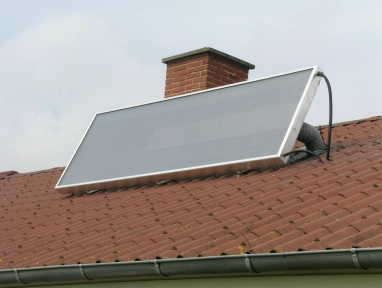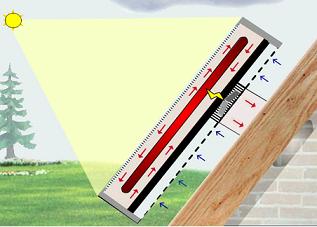Day to day living increases the level of humidity in a property – from breathing, cooking, ironing, washing, showers, baths, and so on. Once the air becomes very damp, moisture starts to settle on cold surfaces and in corners and crevices often resulting in problems with condensation and mould.
This is particularly troublesome in old houses, poorly insulated buildings, irregularly used buildings, caravans, and boats. In the summer months this is not so much of a problem since the air outside is relatively warm and dry, and windows and doors are often left open. In the winter however, the problem is accentuated since doors and windows are kept shut to keep the heat in and the cold out potentially leading to a serious build up of moisture.
The higher the level of moisture in the air, the harder your heating system has to work – it takes more energy to heat humid air than to heat dry air. Therefore, as humidity builds up, keeping your home warm also costs you more money.
SolarVenti

SolarVenti (pictured above) is a solar air collector designed to dehumidify, ventilate, and heat the air in a property removing damp stale air and replacing it with warm dry air. The back of the solar panel is perforated with hundreds of small holes through which fresh air is sucked into the panel whenever the sun shines. This air is circulated through the panel heating it up before it is pushed into the property with a fan powered by a solar PV panel.

The SolarVenti does not actually have a dehumidifier built into it; it dehumidifies by replacing the damp air in the property with relatively dry fresh air from outside – dry since it is sunny when the system operates and so humidity is likely to be low (or at least lower than the stale air trapped in the property). The air is filtered through a felt absorber before being passing into the property and so external dust is kept out. As the fresh air is pushed into the house, stale air is pushed out through the existing ventilation in the property (e.g. door frames, window trickle vents, and so on).
At night, and in cloudy conditions, the SolarVenti does not operate; and in periods of hot weather, it can be turned off to prevent the interior of the property getting too hot. A range of five different models are currently available offering different sizes for different requirements. All but the two smallest are fitted with air flow regulators. By reducing the air flow, the air in the solar panel is heated more – ideal for the cold winter months, but for warmer months, the air flow can be increased so that a large volume of dry fresh air enters the property without it getting too hot.
The only moving part of the SolarVenti is the fan, and so this it is this which will likely determine the life expectancy of the system. SolarVenti is marketed a having a life expectancy of “20+ years”, in part thanks to its Sunon fan which should last 30,000 hours of operation corresponding to around 25 years of typical usage (3 hours per day on average).
The clear front sheet on the panel is made of UV resistant and very sturdy but lightweight Lexan (a type of plastic), and the rivets and screws are all made from aluminium and stainless steel to give corrosion resistance even in marine environments.
To fit a SolarVenti the property must have an unshaded wall or roof facing in a generally Southern direction (South East to South West).
Buy a SolarVenti System
For more information about SolarVenti, click here to visit the official Solar Venti website from GB Energy.
DIY Solar Air Heaters
For those of you interested in attempting to put something like this together for yourselves – have a look at our Make a Simple Solar Air Heater article.